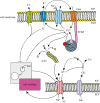Ion channels in cancer: future perspectives and clinical potential
- PMID: 24493756
- PMCID: PMC3917362
- DOI: 10.1098/rstb.2013.0108
Ion channels in cancer: future perspectives and clinical potential
Abstract
Ion transport across the cell membrane mediated by channels and carriers participate in the regulation of tumour cell survival, death and motility. Moreover, the altered regulation of channels and carriers is part of neoplastic transformation. Experimental modification of channel and transporter activity impacts tumour cell survival, proliferation, malignant progression, invasive behaviour or therapy resistance of tumour cells. A wide variety of distinct Ca(2+) permeable channels, K(+) channels, Na(+) channels and anion channels have been implicated in tumour growth and metastasis. Further experimental information is, however, needed to define the specific role of individual channel isoforms critically important for malignancy. Compelling experimental evidence supports the assumption that the pharmacological inhibition of ion channels or their regulators may be attractive targets to counteract tumour growth, prevent metastasis and overcome therapy resistance of tumour cells. This short review discusses the role of Ca(2+) permeable channels, K(+) channels, Na(+) channels and anion channels in tumour growth and metastasis and the therapeutic potential of respective inhibitors.
Keywords: Ca2+ channels; K+ channels; anion channels; apoptosis; cell proliferation; migration.
Figures
Similar articles
-
Ion channels and transporters in tumour cell migration and invasion.Philos Trans R Soc Lond B Biol Sci. 2014 Feb 3;369(1638):20130102. doi: 10.1098/rstb.2013.0102. Print 2014 Mar 19. Philos Trans R Soc Lond B Biol Sci. 2014. PMID: 24493750 Free PMC article. Review.
-
Functional properties of ion channels and transporters in tumour vascularization.Philos Trans R Soc Lond B Biol Sci. 2014 Feb 3;369(1638):20130103. doi: 10.1098/rstb.2013.0103. Print 2014 Mar 19. Philos Trans R Soc Lond B Biol Sci. 2014. PMID: 24493751 Free PMC article. Review.
-
Ion transport and cancer: from initiation to metastasis.Philos Trans R Soc Lond B Biol Sci. 2014 Feb 3;369(1638):20130092. doi: 10.1098/rstb.2013.0092. Print 2014 Mar 19. Philos Trans R Soc Lond B Biol Sci. 2014. PMID: 24493741 Free PMC article. No abstract available.
-
Pharmacological targeting of ion channels for cancer therapy: In vivo evidences.Biochim Biophys Acta. 2016 Jun;1863(6 Pt B):1385-97. doi: 10.1016/j.bbamcr.2015.11.032. Epub 2015 Nov 30. Biochim Biophys Acta. 2016. PMID: 26658642 Review.
-
Ion channels and transporters in the development of drug resistance in cancer cells.Philos Trans R Soc Lond B Biol Sci. 2014 Feb 3;369(1638):20130109. doi: 10.1098/rstb.2013.0109. Print 2014 Mar 19. Philos Trans R Soc Lond B Biol Sci. 2014. PMID: 24493757 Free PMC article. Review.
Cited by
-
Methylation gene KCNC1 is associated with overall survival in patients with seminoma.Oncol Rep. 2021 May;45(5):73. doi: 10.3892/or.2021.8024. Epub 2021 Jun 9. Oncol Rep. 2021. PMID: 34105734 Free PMC article.
-
Oxidative Stress and Immune Response in Melanoma: Ion Channels as Targets of Therapy.Int J Mol Sci. 2023 Jan 3;24(1):887. doi: 10.3390/ijms24010887. Int J Mol Sci. 2023. PMID: 36614330 Free PMC article. Review.
-
Effect of Sigma-1 Receptors on Voltage-Gated Sodium Ion Channels in Colon Cancer Cell Line SW620.Bioelectricity. 2019 Sep 1;1(3):158-168. doi: 10.1089/bioe.2019.0015. Epub 2019 Sep 16. Bioelectricity. 2019. PMID: 34471818 Free PMC article.
-
Necrosis, and then stress induced necrosis-like cell death, but not apoptosis, should be the preferred cell death mode for chemotherapy: clearance of a few misconceptions.Oncoscience. 2014 Jul 3;1(6):407-22. doi: 10.18632/oncoscience.61. eCollection 2014. Oncoscience. 2014. PMID: 25594039 Free PMC article. Review.
-
Chorein sensitive microtubule organization in tumor cells.PeerJ. 2023 Sep 20;11:e16074. doi: 10.7717/peerj.16074. eCollection 2023. PeerJ. 2023. PMID: 37744224 Free PMC article.
References
-
- Djamgoz MB, Onkal R. 2013. Persistent current blockers of voltage-gated sodium channels: a clinical opportunity for controlling metastatic disease. Recent Patents Anticancer Drug Discov. 8, 66–84. - PubMed
-
- Lang F, Hoffmann EK. 2012. Role of ion transport in control of apoptotic cell death. Compr. Physiol. 2m 2037–2061. - PubMed
Publication types
MeSH terms
Substances
LinkOut - more resources
Full Text Sources
Other Literature Sources
Miscellaneous


